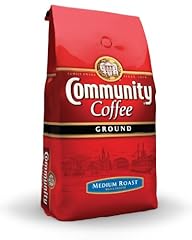 |
| Community Coffee's Medium Roast |
Today I'll be sampling Community Coffee's Medium Roast, brewed in a Curtis D500/D60gt Coffeemaker.
What the Community Coffee website has to say: This extraordinarily aromatic and light-roasted coffee blend produces a fragrant, sweet, and mellow cup of coffee.
 |
| Curtis D500/D60gt Coffeemaker |
What I have to say: Community Coffee's Medium Roast is a thicker bodied, well-balanced coffee. With an intense floral flavor, and fruity aroma, this coffee seems sure to please even the pickiest of coffee connoisseurs. I definitely recommend this coffee, and suggest it be paired with muffins or toast. I made a whole air-pot of this delectable brew, and I might have to change what I drink at home. Honestly, the way its packaged really says a lot about the quality.
Status: Recommended
Speaking of packaging and storing coffee, vacuum sealed, opaque containers are undoubtedly the best way. Coffee exposed to air for too long a period will go stale, and the oils that the bean secretes during the roasting process will eventually go rancid. Ground beans are the most susceptible to this, while "green", unroasted beans store quite readily.
Preferably ground coffee should be purchased in quantities that can be killed off within a week of opening the original packaging. Storing ground coffee in the fridge is is a futile attempt at prolonging freshness, as it's just not cold enough to keep your coffee from going stale. Trying to freeze ground coffee in a conventional freezer, also, doesn't work. When ground, the coffee just has too much surface area to freeze correctly.
Whole roasted coffee beans can store nicely for up to two weeks on the shelf, and for around 2 months in the freezer. Green, unroasted coffee beans on the other hand, can last up to a year on the shelf if stored in a vacuum sealed, opaque container.
Note that these time frames are guidelines to keeping coffee at
peak freshness, and that factors such as humidity, and altitude can be a major factor. In general, keeping your coffee away from natural sunlight, air, and moisture will keep it tasting better longer.
 For 60 years this is the coffee that has reigned as the champion of the daily drinkers. Its smooth taste, refreshingly light acidity, bitter-less aftertaste, and chocolaty flavor have put this coffee on the top shelf in the homes of countless millions. I say that this is one of the most drinkable, and easy to enjoy coffees on the market. If you haven't tried it yet, you've been missing out indeed.
For 60 years this is the coffee that has reigned as the champion of the daily drinkers. Its smooth taste, refreshingly light acidity, bitter-less aftertaste, and chocolaty flavor have put this coffee on the top shelf in the homes of countless millions. I say that this is one of the most drinkable, and easy to enjoy coffees on the market. If you haven't tried it yet, you've been missing out indeed.













